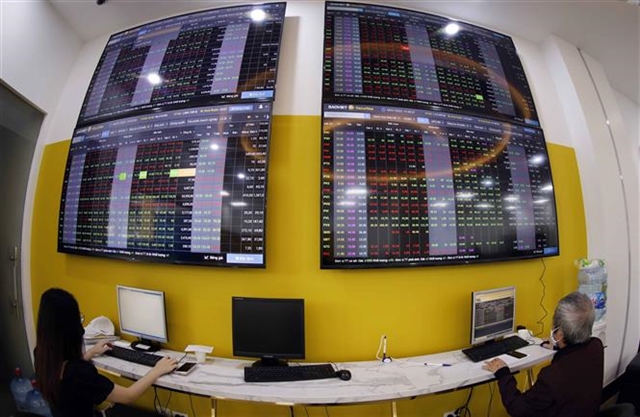 Economy
Economy

 |
| Customers trade on a trading floor in Hà Nội. — VNA/VNS Photo |
HÀ NỘI — The stock market experienced a notable rebound in the first week of June, though liquidity remained inadequate.
Throughout the week, the flow of funds continued to show diversification and rapid movement, yet the technology sector maintained its appeal, emerging as the standout with exceptional growth.
As the business results of the second quarter are not yet released, macro-economic factors, both domestically and internationally, continue to be the main catalysts in the stock market. Hence, the uptrend is expected to continue this week.
On the Hồ Chí Minh Stock Exchange (HoSE), the VN-Index concluded last week at 1,287.58 points, while the HNX-Index on the Hà Nội Stock Exchange (HNX) closed at 244.99 points. Over the week, the former surged by 2.05 per cent and the latter saw a modest increase of 0.78 per cent.
Liquidity on HoSE saw a slight uptick, with the market's trading value reaching VNĐ22.8 trillion per session (US$897 million), reflecting a marginal 0.03 per cent increase from the previous week.
Foreign investors continued their net selling trend, despite a brief return to net buying midweek, which was minimal in value. Over the five sessions, foreign investors sold a net value of VNĐ1.686 trillion across the market, including VNĐ1.649 trillion via order matching and VNĐ37 billion via negotiated transactions.
The market reacted to various significant developments last week, including the Bank of Canada (BOC) leading the G7 nations by cutting interest rates from 5 per cent to 4.75 per cent for the first time in four years.
Following suit, the European Central Bank (ECB) also reduced its rates to 3.75 per cent, marking the first cut since 2019 after maintaining steady policy since July 2023.
Crude oil prices plummeted to a four-month low following the OPEC+ decision to begin reversing voluntary production cuts by the end of this year.
Concurrently, global gold prices declined, and with the State Bank of Vietnam's decision to sell gold through four State-owned commercial banks, domestic SJC gold prices dropped sharply to VNĐ76.98 million per tael from VNĐ87 million the previous weekend (31 May), reducing the gap with global prices to over VNĐ4 million per tael.
Nguyễn Khắc Thành, an analyst at Sài Gòn-Hà Nội Securities (SHS), observed that after a week of adjustments and testing the 1,260-point level, the VN-Index saw a strong rise of 18 points on the first trading day of the week.
This momentum kept the market buoyant in subsequent sessions, with the VN-Index now operating within the 1,250-1,300 points range.
Commenting on market trends, the SHS expert provided an analysis noting that at the end of May, the VN-Index rose by 4.32 per cent compared to April. The market's first trading week of June was fairly positive.
During the week, the index faced continuous pressure, adjusting each time it approached the 1,295-point resistance, corresponding to the March peak.
Currently, the VN-Index closed at 1,287 points, equivalent to the highest price range during the significant surge on April 15, and also matching the peak prices of June-August 2022. Additionally, the VN30 rose to 1,308 points, surpassing the highest price level in March.
According to a report from Việt Dragon Securities, net selling by investors in May reached VNĐ15.6 trillion, with the trend persisting. For domestic investors, macro-economic factors, both locally and internationally, are expected to be the primary catalysts as the market moves into June.
Việt Dragon's analysts anticipate that the VN-Index will trade within the 1,250-1,320 range in June.
In a positive macro-economic scenario, the index is expected to maintain momentum and surpass recent short-term peaks.
Conversely, stronger exchange rate pressures could challenge the central bank's ability to maintain the current interest rate levels, potentially negatively impacting investor expectations and market indices. — VNS




